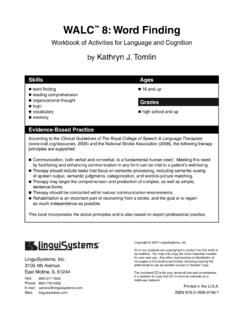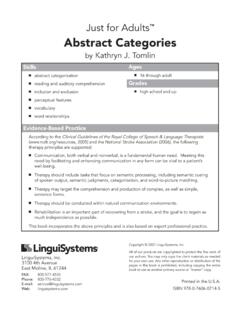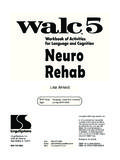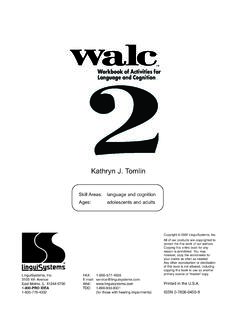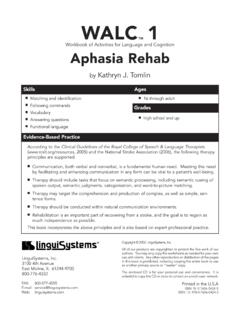Transcription of Just for Adults Concrete Categories - Affiliated Rehab
1 Just for Adults Concrete Categoriesby Kathryn J. TomlinLinguiSystems, 4th AvenueEast Moline, IL 61244 FAX: 800-577-4555 Phone: 800-776-4332E-mail: Concrete categorization reading and auditory comprehension inclusion and exclusion vocabulary word relationshipsEvidence-Based PracticeAccording to the Clinical Guidelines of the Royal College of Speech & Language Therapists ( , 2005) and the National Stroke Association (2006), the following therapy principles are supported: Communication, both verbal and nonverbal, is a fundamental human need. Meeting this need by facilitating and enhancing communication in any form can be vital to a patient s well-being.
2 Therapy should include tasks that focus on semantic processing, including semantic cueing of spoken output, semantic judgments, categorization, and word-to-picture matching. Therapy may target the comprehension and production of complex, as well as simple, sentence forms. Therapy should be conducted within natural communication environments. Rehabilitation is an important part of recovering from a stroke, and the goal is to regain as much independence as book incorporates the above principles and is also based on expert professional 16 through adultGrades high school and upCopyright 2007 LinguiSystems, of our products are copyrighted to protect the fi ne work of our authors.
3 You may only copy the client materials as needed for your own use. Any other reproduction or distribution of the pages in this book is prohibited, including copying the entire book to use as another primary source or master in the 978-0-7606-0715-2 Just for Adults Concrete Categor1 14/30/2008 10:20:17 AMAbout the AuthorKathryn J. Tomlin, , CCC-SLP, has been a speech-language clinician in hospitals, rehabilitation centers, and in long-term care facilities for over 25 years. She has authored many materials with LinguiSystems over the last 20 years. Some of her works include:WALC 1 (Workbook of Activities for Language and Cognition) Aphasia RehabWALC 2 Cognitive RehabWALC 8 Word FindingWALC 9 Verbal and Visual ReasoningWALC 10 MemoryWALC 11 Language for Home ActivitiesThe Source for Apraxia TherapyZanmi, Kathy s Samoyed, goes to work with her to encourage the clients.
4 Her clients enjoy feeding and spending time with Zanmi, and Zanmi enjoys their company. Everybody wins!DedicationThis book is respectfully dedicated to Danielle Fedele. Thanks for all your help in using the exercises in this series of books. I couldn t have done it without you. May your journey in the world of speech/language pathology be fulfi lling and by Lauri WhiskeymanPage Layout by Christine BuysseCover Design by Jeff TaylorIllustrations by Margaret WarnerKathy and her therapy dog, ZanmiJust for Adults : Concrete Categories 3 Copyright 2007 LinguiSystems, of ContentsIntroduction.
5 4 Screening .. 6 Selecting Category Name Three Choices .. 7 Selecting Category Member Three Choices .. 9 Matching Across Columns ..11 Matching Category to Member .. 13 Locate Similar Category Items .. 15 Sorting Four Category Choice .. 17 Selecting Category Members .. 19 Pictures of Category Items .. 21 Locating Animals in Sentences .. 23 Locating Furniture in Sentences .. 24 Exclusion Which Doesn t Belong? .. 25 Name Category Member from Description .. 27 Provide a Category Member Given First Letter .. 29 Name Category from List of Members .. 31 Complete the List.
6 33 Listing Location Items .. 35 Listing Category Items .. 37 Answer Key .. 39 Just for Adults : Concrete Categories 4 Copyright 2007 LinguiSystems, is an integral part of our daily communication. We categorize in multiple ways every day. We categorize when we get dressed, when we choose what to eat, when we go shopping, when we plant gardens, and so on. But the ability to categorize is frequently impaired in someone who has language or thinking diffi culties. It can become very confusing or overwhelming if categorization skills are factors can hinder one s ability to categorize, such as: Diffi culty understanding language or concepts due to aphasia.
7 Diffi culty utilizing convergent language skills. Diffi culty mentally manipulating information and coming to a conclusion. Impulsivity causing action before receiving and analyzing all pertinent information. Becoming overwhelmed with mentally-held information and new exercises in Just for Adults : Concrete Categories have been developed to address Concrete categorization. Concrete categorization refers to things that are defi nite and tangible as opposed to abstract categorization which addresses intangible qualities and characteristics. Concrete categorization skills are foundational for many language and thought processes and for activities of daily exercises can be done in multiple ways.
8 Have clients read items silently and complete them independently. Have clients read task items aloud and write the response. In general, performance improves when a person has multi-modality input ( , hearing it while reading it). Read the items to the client and have the client give responses page 6, you will fi nd a screening tool that is not to be used as a test but rather as a way to observe a client s use of strategies and reasoning patterns. Some questions to think about while observing how the client completes the screening include: 1. Does the client need to use verbal rehearsal to aid comprehension?
9 2. Is the client impulsive, and does his impulsivity lead to errors? 3. Does the client read too much into the task and become confused? 4. Is the client aware of his error responses? 5. Does the client ask for clarifi cation when having diffi culty or does he just keep going, whether the item is understood or not? 6. Does the client miss salient information? 7. Is the client able to think convergently and divergently? 8. Does the client have trouble shifting from one task to the next?Just for Adults Concrete Categor4 44/30/2008 10:21:32 AMJust for Adults : Concrete Categories 5 Copyright 2007 LinguiSystems, guidelines will help you present the activities in this book.
10 The goals of these exercises are to improve a person s ability to converge upon specifi c members of a category and to think divergently to determine the category to which members belong. These abilities to converge and diverge information are foundational skills in many cognitive functions. Be fl exible with presentation and accept answers that differ from your viewpoint if the client can give a logical explanation. The answers in the Answer Key are provided as a reference and are not intended to be all inclusive. The exercises are not for testing purposes. Try to make them as enjoyable as possible.
